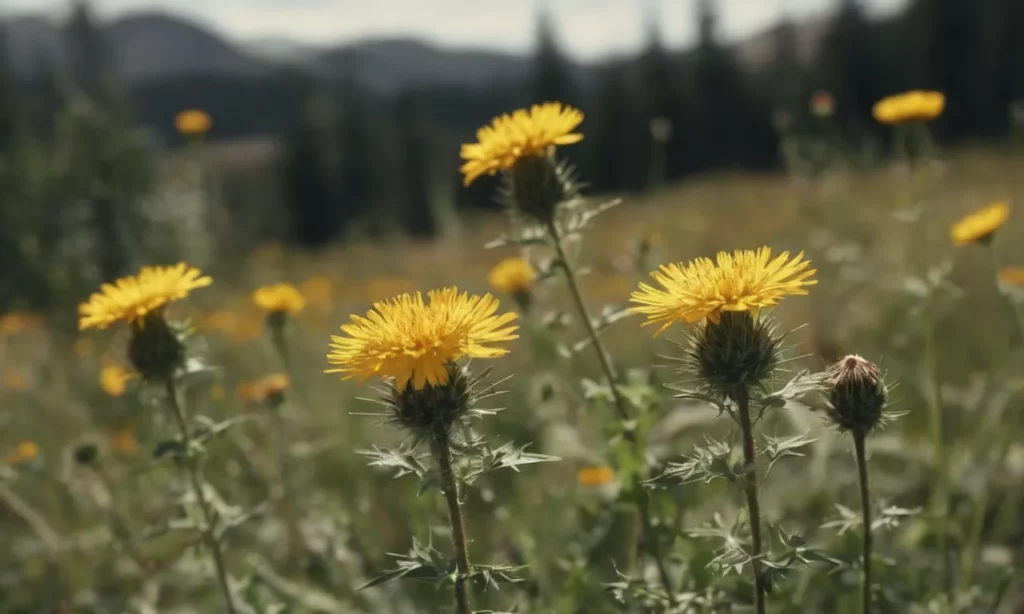Comprehensive Guide to Hawkweed: Facts, Uses, and Features

Hawkweed, also known as Hieracium pilosella, is a fascinating perennial plant that belongs to the expansive Asteraceae family. With its bright yellow flowers and distinctive appearance, this plant has a lot more to offer than meets the eye.
In its native Eurasia and introduced ranges like North America and New Zealand, hawkweed grows in dry, sunny areas with sandy soil, especially in less fertile locales. While it can be an invasive weed, hawkweed has a long history of use in European ethno-medicine.

Let’s explore 9 fascinating facts about this unique plant:
1. Hawkweed Has a Variety of Traditional Medicinal Uses
For centuries, hawkweed has been utilized in folk medicine to treat issues like urinary tract inflammations, skin diseases, coughs, and respiratory conditions. The entire plant contains beneficial bioactive compounds.
In particular, hawkweed has diuretic, astringent, antiseptic, and antiphlogistic properties. Traditional practices used it for phytotherapy of hypertension and obesity. Scientifically studied applications include treatment of cellulitis, cystitis, nephritis, urolithiasis, and respiratory tract inflammations.
In Polish folk medicine, hawkweed treated coughs and septic wounds. While more research is still needed, the long medicinal history of hawkweed is a fascinating fact.
2. The Plant Spreads Through Rhizomes and Stolons
Unlike some plants that only reproduce by seed, hawkweed is able to spread via rhizomes and stolons. Rhizomes are horizontal underground stems that can send up new shoots and develop into new plants. Stolons are horizontal aboveground stems that can root at the nodes.
This ability to propagate vegetatively makes hawkweed colonize and cover ground efficiently. Dense clonal colonies compete with other plants, contributing to hawkweed’s success as an invasive species in some regions. The extensive rhizome network makes manual and mechanical control difficult.
3. There Are Dozens of Hawkweed Species
Although Hieracium pilosella is the most widely recognized species, there are actually between 850-1000 species of hawkweed worldwide[1]. The taxonomy is complex and identification can be challenging.
Some of the major species include the European native H. pilosella, the invasive orange hawkweed (H. aurantiacum) and meadow hawkweed (H. caespitosum) in North America, and the woolly hawkweed (H. florentium) native to Britain. There is still debate among taxonomists regarding the classification.
4. Hawkweeds Grow Well in Poor Soils
An interesting fact about hawkweed is its ability to thrive in acidic, low fertility soils where other plants struggle. The extensive root system efficiently absorbs nutrients and the rhizome network helps hawkweed spread over poor ground.
In rich soils with high nitrogen, hawkweed growth is reduced. It doesn’t compete well with grasses and other plants in highly fertile areas. The adaptation to poor soils gives hawkweed an edge in disturbed, eroded, and degraded areas.
5. The Plant Exhibits Allelopathic Properties
Certain hawkweed species demonstrate allelopathic properties, meaning they release biochemicals that inhibit other plant growth. Orange hawkweed contains phenolic compounds in its leaves and flowers that hinder seed germination and seedling growth of nearby plants.
The toxins released by hawkweed provide a competitive advantage by suppressing neighboring plant growth. This allelopathic ability further enables hawkweed to form dense colonies in introduced ranges where native plants lack adaptations to deal with the chemicals.
6. Hawkweed Has Bright Yellow Flower Heads

The bright golden yellow flowers of Hieracium pilosella are a distinctive feature. The 0.6-0.8 in (15-20 mm) flower heads are borne singly on leafless stalks rising above the foliage. They resemble the flowers of dandelions, which are also in the Asteraceae family.
The individual flowers are strap-shaped ray florets. Flowering occurs from spring to fall, with peak bloom in summer. The floral display attracts pollinating insects with its color and readily available nectar. Reseeding contributes to hawkweed’s spread.
7. People Once Believed Hawkweed Fed Hawks’ Vision
The ancient Greeks called the plant Hieracium, meaning hawkweed or hawk’s plant. This intriguing name refers to the myth that hawks consumed hawkweed plants to sharpen their eyesight when hunting.
The genus name has persisted to modern times. While hawks don’t actually use the plant for visual enhancement, the legend reveals historical connections between raptors and hawkweed. The distinctive yellow flowers stretching toward the sun resemble a bird reaching for the sky.
8. It Has Basal Rosettes of Hairy Leaves
Hawkweed starts its growth as a basal rosette close to the ground. The leaves are oval to lance-shaped, sometimes toothed, and arranged in a circle radiating out from the center. The foliage is hairy, giving it a grayish appearance.
Leaves may reach up to 6 in (15 cm) long and 0.8 in (2 cm) wide, extending from short leafstalks. As the plant bolts, leaves become smaller higher up the flower stalks. The basal rosette is a key identification feature separating hawkweed from other superficially similar yellow-flowered plants.
9. The Plant Contains a Bitter, Milky Latex
When leaves or stems are broken, hawkweed exudes a milky white latex that is bitter to taste and can irritate skin. This distinguishes hawkweed from dandelions, which have a clear, watery latex.[2]
The milky sap deters herbivores from feeding on the plant. It also contains complex chemicals such as sterols, terpenes, flavonoids, and phenolic acids that underlie the bioactivity of hawkweed extracts used in folk medicine.

Key Takeaways
The unique growth habits, adaptations, and folklore surrounding hawkweed make it a fascinating plant. Even where considered an unwanted invasive weed, understanding its complex biology provides insight into managing it responsibly. Looking closely at hawkweed reveals an intriguing hidden world.





